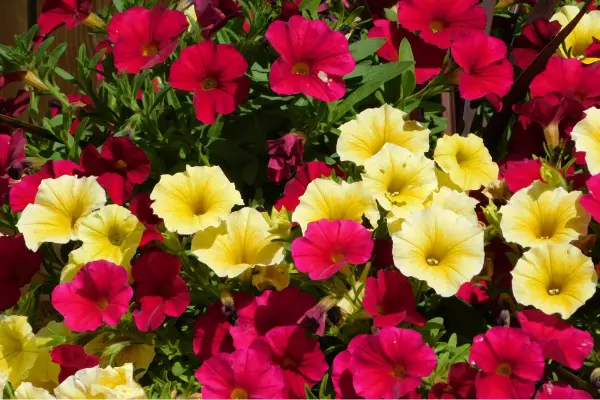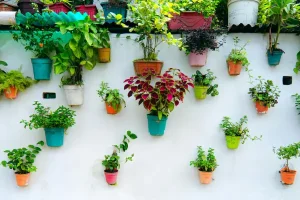Petunias and pansies are two of the most popular flowering plants for vertical gardens. They’re colorful, adaptable, and perfect for brightening balconies, patios, or even indoor living walls. But while they’re relatively easy to grow, many gardeners struggle to keep them thriving through the changing seasons.
With the right care, petunias and pansies can reward you with blooms almost year-round. This guide walks through seasonal strategies, maintenance tips, and common mistakes to avoid so your vertical garden stays vibrant in every season.
Why Petunias and Pansies Work in Vertical Gardens
Petunias and pansies bring steady color, easy care, and a tidy shape that fits small spaces—perfect for pockets, panels, and hanging towers. They handle the unique conditions of vertical gardening and make refreshing a wall as simple as swapping a few modules.
Compact growth habit: Both stay manageable in pockets, baskets, or wall planters. Trailing petunias can “spill” over edges for soft movement, while pansies form neat mounds that fill gaps without crowding neighbors.
Continuous blooms: With proper care, petunias flower from spring through fall; pansies shine in cooler months and winter-friendly rooms. Rotate them seasonally for near year-round color.
Color variety: From bold magentas and deep purples to soft pastels and bi-colors, you can build clean color blocks or playful mixes that photograph beautifully.
Adaptability: They thrive in containers, hanging baskets, and modular systems, and they respond well to drip irrigation or hand-watering.
Pollinator friendly: Petunias attract bees and hoverflies in warm months; pansies add nectar when fewer options are blooming.
Fast refresh: If a pocket looks tired, replace a single plant without reworking the whole wall—budget friendly and low hassle.
Simple care: Use a light, well-draining mix; water when the top inch feels dry; feed lightly every 2–3 weeks. Deadhead pansies often and trim petunias back by a third when they get leggy to trigger fresh blooms.
Smart placement: Put sun-loving petunias on brighter tiers and tuck pansies into cooler, slightly shadier spots for best results.
Seasonal Care Guide
Spring
- Petunias: Start seeds indoors 8–10 weeks before the last frost, or buy transplants. Move outdoors once frost danger passes.
- Pansies: Ideal for early spring planting; they tolerate cool nights.
- Tasks:
- Refresh vertical garden soil or growing medium.
- Fertilize lightly with a balanced fertilizer.
- Watch for early pests like aphids.
- Refresh vertical garden soil or growing medium.
Summer
- Petunias: Peak bloom season. Deadhead regularly to encourage new flowers.
- Pansies: Often struggle in heat—consider replacing them with heat-loving plants or move them to shaded spots.
- Tasks:
- Increase watering, especially for wall-mounted gardens that dry quickly.
- Provide partial shade during extreme heat.
- Feed with a liquid fertilizer every two weeks.
- Increase watering, especially for wall-mounted gardens that dry quickly.
Fall
- Petunias: Can continue blooming until frost with regular feeding.
- Pansies: Thrive in cooler temperatures and can be planted for fall color.
- Tasks:
- Remove faded summer plants.
- Add fresh soil or compost to replenish nutrients.
- Plant pansies in empty pockets for fall displays.
- Remove faded summer plants.
Winter
- Petunias: Usually annuals in cold climates; replace in spring unless overwintered indoors.
- Pansies: Hardy in many regions and can survive frost and light snow.
- Tasks:
- Protect vertical gardens with frost cloth if outdoors.
- Move containers indoors or to sheltered areas if temperatures drop below freezing.
- Water sparingly; roots grow slowly in cold weather.
- Protect vertical gardens with frost cloth if outdoors.
Quick Care Reference Table
| Season | Petunia Care | Pansy Care |
| Spring | Transplant, fertilize, watch for pests | Plant early, tolerate cool nights |
| Summer | Peak bloom, deadhead, shade in heat | Struggle in heat, provide shade |
| Fall | Continue blooming until frost | Plant for fall color |
| Winter | Annual in cold climates, overwinter indoors | Hardy, may survive frost with protection |
General Maintenance Tips
- Deadheading: Remove spent blooms weekly to encourage new flowers.
- Fertilizing: Use balanced fertilizer every two weeks during blooming season.
- Watering: Vertical gardens dry out faster—check daily in hot weather.
- Pruning: Trim leggy growth to keep plants compact and full.
- Rotation: Swap plants seasonally for continuous color.
Common Mistakes to Avoid
- Overwatering in Winter
Roots grow slowly in cold weather, so too much water causes rot. - Neglecting Fertilizer
Petunias are heavy feeders; without regular feeding, blooms fade quickly. - Planting Pansies in Full Summer Sun
They prefer cooler temperatures and partial shade in warm months. - Forgetting to Refresh Soil
Nutrients deplete quickly in vertical systems. Replace or amend soil each season.
FAQs
Q: Can petunias survive winter?
In warm climates (zones 9–11), yes. In cooler regions, they’re annuals unless overwintered indoors.
Q: Are pansies perennial or annual?
They’re technically short-lived perennials but are often grown as annuals for cool-season color.
Q: Can I mix petunias and pansies in the same vertical garden?
Yes. Plant petunias in spring and summer, then swap them for pansies in fall and winter.
Q: How do I keep petunias blooming longer?
Regular deadheading, pruning, and biweekly feeding keep flowers coming through the season.
Next Steps & Related Reading
If you love floral displays, read How to Create a Living Wall of Seasonal Blooms for design tips.
For year-round system care, check out Seasonal Maintenance Checklist for Vertical Growing Systems.
Conclusion
Petunias and pansies are perfect companions for vertical gardens, offering color in opposite seasons. By rotating them and adjusting care for each season, you can enjoy a continuous display of blooms throughout the year.
The key is regular maintenance—deadheading, fertilizing, and seasonal swaps. With these steps, your vertical garden will stay vibrant from spring through winter.
Do you prefer the bold colors of petunias in summer or the cheerful resilience of pansies in winter?




